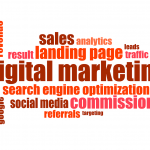Making the most of social media

In my last series I discussed the pros and cons of Outsourcing v Offshoring. In this series I’ll explore some of the social media platforms, discussing which ones I recommend for business, and some tips in using them.
Why use social media for business purposes at all – isn’t it ‘social’ and not ‘business’? The most practical reasons to use social media have to do with your credibility and discoverability. It’s important because it’s expected, like having a website, a phone number and an email address, however, just because everyone else is on social media is not a good enough reason to be on social media.
Social media for business should go a step further and should be used with tangible purpose, and with a goal in mind be it to create leads, sales, have orders being placed, bums on seats or whatever.
Without this purpose or strategy, you don’t know what social media marketing you should doing, what you should do more or less of, and you would not have something tangible to measure the effectiveness of your social media engagement.
There are a range of social media platforms – Twitter, Facebook, LinkedIn, Instagram, Pinterest, Google+, Blab and the list goes on… and on… and on. So, which social media platform should you be using in your marketing and why? Don’t try and use them all – you’ll spread yourself far too thin and not have enough time on any platform to achieve your social media purpose.
As a rule of thumb, there are only three that I would use for business:
• Twitter
• Facebook
• LinkedIn
But first a short primer on what is Twitter, LinkedIn and Facebook.
Twitter is a short message communication tool that allows you to send out messages (tweets) up to 140 characters long to people who subscribe to you (followers) and also your followers’ followers. Because the messages are short it is also extremely fast paced thus creating a lot of ‘noise’ which scares people off Twitter, however, it does allow almost instantaneous communication to a target audience.
LinkedIn launched in 2003 and is currently the fourth most popular social network among adults. LinkedIn is primarily centered around careers, and it enables users to connect and share content with other professionals, including colleagues as well as potential employers, business partners, new employees, and most importantly for businesses – potential customers.
With more than 2 billion active users, Facebook is currently the biggest social media platform in the world. Because of its wide potential reach, many businesses have found it useful for advertising and connecting with customers. Facebook can be thought of as your little piece of personal real estate on the internet where you get to customise your profile and make status updates to communicate with your customers or potential customers.
You even get current and personalised news of customers (and competitors) updates as well as updates from brands, blogs, and public figures delivered to you via the news feed.
Matching purpose to platform
To refine the three platforms to use further, if you’re a business to consumer (B2C) business then I would recommend just focusing on Twitter and Facebook. If you’re a business to business (B2B) business, then I would just use Twitter and LinkedIn.
LinkedIn isn’t the place where one discusses what they bought at a shop, or where they’re having dinner and what it was like. It’s a platform discussing business related topics and hence it is the place for businesses to connect and my preferred platform for B2B social media.
Facebook, however, is a platform where you may discuss personal experiences that might include products you’ve bought or seek advice on products you want to buy and hence my preferred platform for B2C social media.
Twitter I prefer as a brand awareness platform as it is easy and quick to join in a ‘conversation’.
Get good at using the two applicable platforms for your business first and then perhaps introduce another platform.
Over the next couple of articles, I’ll delve deeper into these three platforms and how to use them as part of your overall marketing strategy. At the end of the series I’ll give some tips and tricks to manage your social media content and engagement for business – because as we all know social media can become all-consuming of one’s time and energy.
Stephen Barnes is a business turnaround and recovery specialist, Board advisor and the principal of management consultancy Byronvale Advisors. He has over 25 years advising clients from new business start-ups to publicly listed companies and across a wide array of industries. He is a crisis manager that prides himself on quickly understanding the client’s business and issues and developing pragmatic solutions to complex problems. He is also the author of ‘Run Your Business Better’. To find out how Stephen can help you run your business better and quickly improve your business performance visit www.byronvaleadvisors.com.








